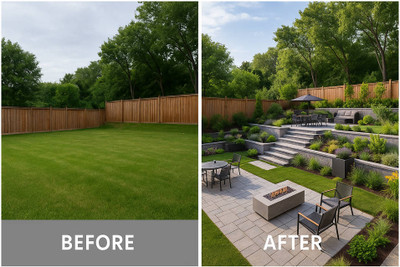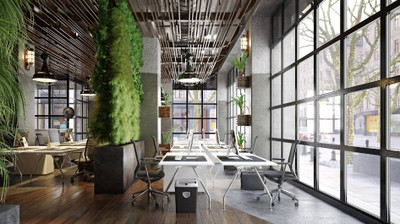6 Different Types of Urban Green Spaces
Posted by Jason Wyrwicz on May 8th 2025

Urban centers worldwide are becoming denser and more fast-paced. It raises an important question – how best to integrate nature into city life?
Many professionals—ranging from store managers to architects—now seek to create environments that balance economic vitality with sustainability and social well-being.
One increasingly popular strategy is the expansion of urban green spaces, which offer a multitude of environmental, economic, and community benefits.
What kinds of green spaces do cities actually need—and how do they differ? Let’s take a look.
Why Urban Green Spaces Matter?
Urban green spaces benefit city dwellers economically, environmentally, and socially. How?
Environmental Benefits
Trees and greenery improve air quality by filtering pollutants and producing oxygen, help cool cities by shading and evapotranspiration (mitigating the urban heat island effect), absorb stormwater runoff, and support urban biodiversity.
Social and Community Benefits
They also create shared public places that draw people outside and foster social interactions, strengthening community bonds. Walkable, green neighborhoods encourage residents to meet, relax, play, and hold events together.
Psychological and Health Benefits
Contact with nature has well-documented positive effects on mental health, stress reduction, and overall well-being. Green views and natural settings help reduce stress, anxiety, and depression, and they improve attention.
Economic Benefits
Finally, green spaces can drive economic value for cities and businesses. Attractive parks and tree-lined streets raise nearby property values and make neighborhoods more desirable.
In retail districts, shoppers spend more time and money in areas with greenery – research shows consumers are willing to spend ~9–12% more in business districts with robust tree canopies. (VIBRANTCITIESLAB.COM)

The Different Types of Urban Green Spaces
Public Parks
Public parks are large expanses of landscaped areas open to everyone. They typically offer recreational amenities, such as walking paths, sports facilities, and picnic zones.
Benefits and Practical Applications
- Being near a well-maintained public park can boost foot traffic and create a positive shopping experience.
- Urban planners see public parks as vital communal assets that strengthen neighborhoods and support physical activity.
Design Considerations
Key features often include ample seating, shade trees, and accessible walkways. Some public parks use open-air amphitheaters for cultural events or integrate water features to enhance visual appeal.
A good example is maybe the most famous park in the world – Central Park in New York City, which successfully blends natural landscapes with recreational facilities, or Stanley Park in Vancouver, well-known for its extensive walkways and biodiversity.
Community Gardens
Community gardens are shared plots where residents grow flowers, vegetables, and herbs. They often operate under cooperative principles, with participants sharing responsibilities for planting, watering, and maintenance.
Benefits in Urban Areas
- These spaces promote education, encourage social bonding, and support local food production—addressing not just environmental but also social and food-security concerns.
- Community gardens often enhance neighborhood pride and are a powerful tool for community building.
Practical Design Considerations
Raised beds and accessible walkways ensure that a diverse group of people can participate. Adequate water supply, sunlight, and secure fencing are also key.
Q Gardens in Brooklyn exemplifies how a well-maintained community garden can become a local gathering point for workshops, communal meals, and casual socializing.

Green Roofs & Rooftop Gardens
Green roofs involve cultivating a layer of vegetation on top of a building. This can be as simple as a thin layer of grass or as elaborate as a fully landscaped rooftop garden.
Benefits of Urban Sustainability and Temperature Regulation
- By insulating buildings against temperature extremes, green roofs reduce energy consumption and help regulate urban microclimates.
- They also manage stormwater effectively, absorbing rainfall and reducing runoff.
- Their visual appeal can boost property values.
Important Design Considerations
Structural load capacity is a top priority: roofs must support the weight of soil, plants, and water. The Chicago City Hall Green Roof is a pioneering example, showcasing how city buildings can creatively adopt green infrastructure to improve air quality and reduce the urban heat island effect.
Streetscapes & Sidewalk Greening
Streetscapes and sidewalk greening refer to the integration of greenery—such as street trees, planters, or small landscaped beds—along roads, walkways, and commercial corridors.

Benefits and Practical Applications
- Lush sidewalks and tree-lined streets make neighborhoods more welcoming, boosting local commerce as pedestrians are more inclined to stroll and explore.
- Trees and planters help filter air pollutants, provide shade, and reduce the “heat island” effect common in dense cities.
- Retailers and store managers situated along greener sidewalks may see increased foot traffic and higher spending as customers appreciate the inviting environment.
Design Considerations
For store managers, well-maintained planters near the storefront can project an eco-friendly brand image and create a more pleasant shopping experience. Interior designers can collaborate with building owners to ensure that the outdoor aesthetic complements interior decor—particularly for open-front or glass-entrance concepts.
Urban Forests & Wildlife Corridors
Urban forests and green corridors are strips of vegetation that connect larger green urban spaces, allowing for wildlife movement and pedestrian-friendly walkways. These pathways can line rivers, railways, or other thoroughfares, linking parks and neighborhoods.
Advantages for Urban Mobility and Ecology
- Green corridors enhance walkability and biking options, encouraging healthier, car-free transit.
- They also serve as ecological lifelines, enabling flora and fauna to move more freely through a city’s built environment.
Design and Planning Considerations
Safe crossing points, consistent landscaping, and clear signage are critical for usability. Dedicated lanes for cyclists and pedestrians reduce conflicts and increase adoption.
The High Line in NYC is a famous example, converting an abandoned railway into a lush, elevated green trail that revitalized the surrounding neighborhood.
Institutional & Commercial Courtyards
Institutional and commercial courtyards are semi-enclosed or open-air areas within buildings—such as schools, corporate offices, medical facilities, and hospitality complexes—designed to incorporate natural elements.
Benefits and Practical Applications
- By merging the indoors with natural features, these courtyards can significantly improve occupants’ psychological well-being and overall health.
- In schools and universities, green courtyards can serve as communal hubs for events or study sessions, helping build a sense of place and institutional identity.
- For commercial or hospitality settings, a thoughtfully designed courtyard can reinforce a company’s commitment to sustainability and create a memorable impression for visitors and clients.
Design Considerations
Opt for species suited to the courtyard’s microclimate—paying attention to shade, ventilation, and seasonal changes. In partially covered or fully enclosed spaces, prioritize varieties that thrive in lower light conditions.
Ensure pathways accommodate people of all abilities. Incorporate comfortable seating areas that encourage interaction and relaxation.

The Role of Modern Fiberglass Planters in Urban Green Spaces
Store managers, interior designers, architects, and urban planners can all benefit from including fiberglass planters for growing greenery in spaces of all sizes.
And this is why:
Applications Across Different Green Spaces
- Public Parks: Place large fiberglass planters at entrances to create a welcoming “green gateway,” or group them around benches for added shade and aesthetic charm.
- Pocket Parks: Maximize limited footprints with vertical planters that line walls or corners, boosting the visual impact without sacrificing walkable space.
- Community Gardens: Use fiberglass planters to delineate plots or raise beds, making them more accessible to senior citizens or individuals with mobility challenges.
- Green Roofs: Reduce load concerns by using fiberglass planters instead of heavy concrete containers, allowing for more extensive landscaping on rooftops.
- Institutional & Commercial Courtyards: In schools, offices, and hospitals, fiberglass planters provide a stylish, low-maintenance way to introduce greenery into courtyards and communal areas.
A few examples of our fiberglass planters used in urban spaces:
How to Choose the Right Green Space for Your Environment?
So, now that you know all the basics, we leave you with a few valuable tips on how to arrange your next green space in an urban area.
1. Identify Your Goals
- Aesthetics: If your primary aim is to enhance visual appeal (e.g., for a retail outlet or luxury hotel), vertical gardens or stylish planters might serve best.
- Functionality: Community gardens or public parks may be more suitable if your main goal is community engagement or recreational space.
- Ecological Impact: Rain gardens, green roofs, and urban forests contribute significantly to environmental sustainability.
2. Evaluate Space, Climate, and Environmental Constraints
Assess the amount of sunlight, wind exposure, and structural load limitations. For example, a green roof must support soil depth and irrigation needs, while a vertical garden requires a sturdy wall and consistent watering
3. Budgeting Considerations
- Installation Costs: Large-scale projects (like public parks or extensive green roofs) may require more substantial initial investments.
- Maintenance Expenses: Smaller urban green space projects, especially those using fiberglass planters, can be more budget-friendly over time due to their durability and ease of maintenance.
4. Long-Term Maintenance and Sustainability Requirements
Factor in watering schedules, pest control, and seasonal adjustments. Community gardens, for instance, rely on volunteer labor for success. Indoor green walls, on the other hand, require specific irrigation systems
Conclusion
Why are green spaces important in urban areas? They offer a triple bottom line of environmental, social, and economic benefits that are increasingly vital to sustainable development.
So, it’s not often the question of if, but how to design urban green spaces for them to be practical, sustainable and financially viable.
Hopefully, after reading this guide, you have a better understanding of this topic. We’re confident, you’re next green city project will be a smashing success!








